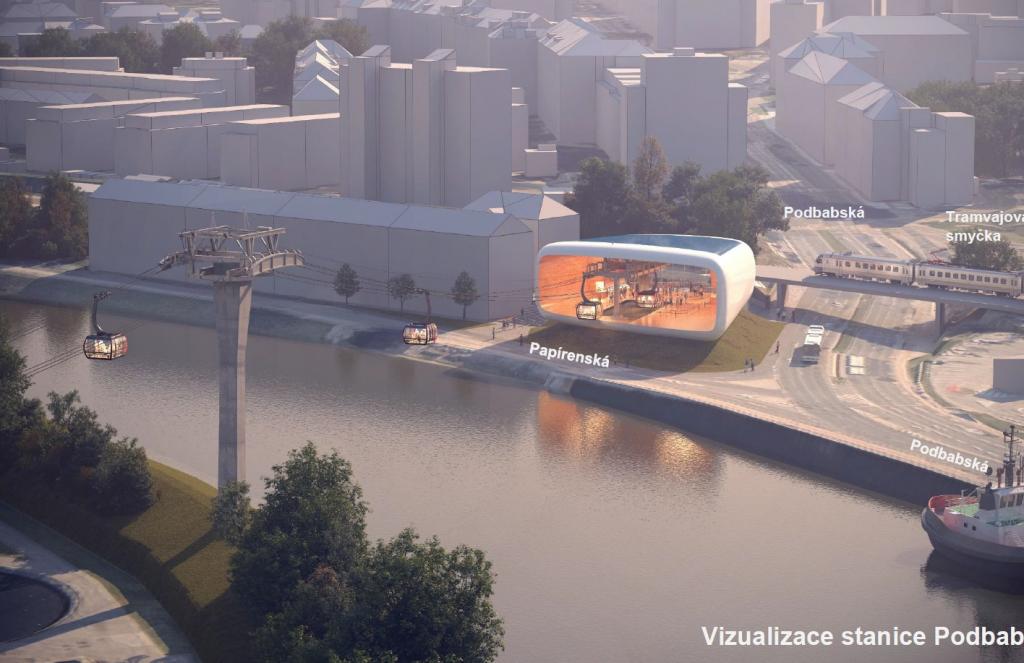Thessaloniki gets ready for its metro launch in November
The underground rapid transit lines have been under construction for almost two decades due to various project delays
 TheMayor.EU logo
TheMayor.EU logo 
Illustration of cable cars across the Vltava River, Source: Prague Public Transport Authority (DPP) on Facebook
They will significantly shorten journeys and offer a beautiful view of the Vltava River
On Friday, the Prague Public Transport Authority (DPP) announced that it is launching a new architectural competition. More specifically, it is searching for ideas for the design of a cableway (3 stations and 5 supporting pillars) that will connect three of the Czech capital's neighbourhoods: Podbaba, Troja, and Bohnice.
The new cable cars will travel a distance of approximately 2.3 kilometres, joining Prague 6 and Prague 8. This means that instead of having to travel for 40 minutes through the city centre, residents and tourists will soon be able to ride a cable car over the Vltava River and significantly shorten their journeys.
In addition to this, the upcoming stations will be integrated with the current tram and bus stops to guarantee more efficient transport solutions. Therefore, the cable cars will become a part of the public transport network, facilitating the commutes of citizens.
Last August, the City Council of Prague approved the plans for the Podbaba – Troja – Bohnice cableway. Subsequently, the DPP conducted consultations with two cable car manufacturers (Doppelmayr and Leitner) to verify the aforementioned plans and estimate the costs of the project. The entire project will now reportedly cost over CZK 2 billion (over EUR 79.2 million).
In a Facebook post, the DPP shared illustrations of what the cableway and cable cars can look like. The Deputy Mayor of Prague Adam Scheinherr also commented on the images, stressing that they do not illustrate how the future cable cars will truly look but rather how they will function.
The official designs will be revealed in 2022 as the winners of the architectural competition will be chosen and announced at the end of January.
To see the illustrations of the future cable cars and stations, see the gallery above.

The underground rapid transit lines have been under construction for almost two decades due to various project delays

Now you can get your wine in Talence by paying directly in Bitcoin

That’s because the state has to spend money on updating the railway infrastructure rather than subsidizing the cost of the popular pass

Rethinking renewable energy sources for the urban landscape

The examples, compiled by Beyond Fossil Fuels, can inform and inspire communities and entrepreneurs that still feel trepidation at the prospect of energy transition

Now you can get your wine in Talence by paying directly in Bitcoin

The 10th European Conference on Sustainable Cities and Towns (ESCT) sets the stage for stronger cooperation between the EU, national and local level to fast track Europe's transition to climate neutrality.

At least, that’s the promise made by the mayor of Paris, Anne Hidalgo

The underground rapid transit lines have been under construction for almost two decades due to various project delays

At least, that’s the promise made by the mayor of Paris, Anne Hidalgo

Hostal de Pinós is located in the geographical centre of the autonomous region

Despite its church-y name, the district has long been known as the hangout spot for the artsy crowds

Urban dwellers across the EU are having a say in making their surroundings friendlier to people and the environment.

Forests in the EU can help green the European construction industry and bolster a continent-wide push for architectural improvements.

Apply by 10 November and do your part for the transformation of European public spaces

An interview with the Mayor of a Polish city that seeks to reinvent itself

An interview with the newly elected ICLEI President and Mayor of Malmö

A conversation with the Mayor of Lisbon about the spirit and dimensions of innovation present in the Portuguese capital














